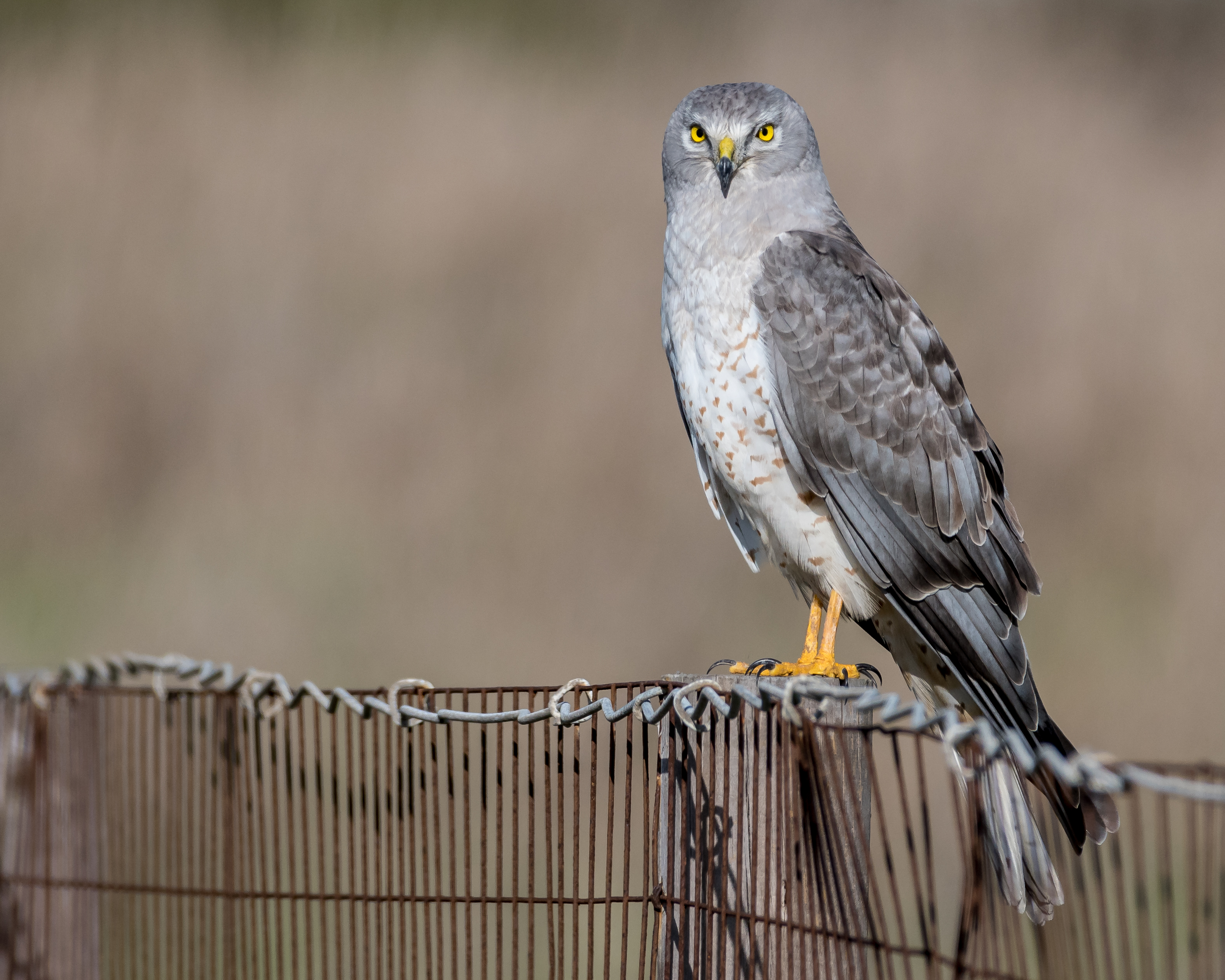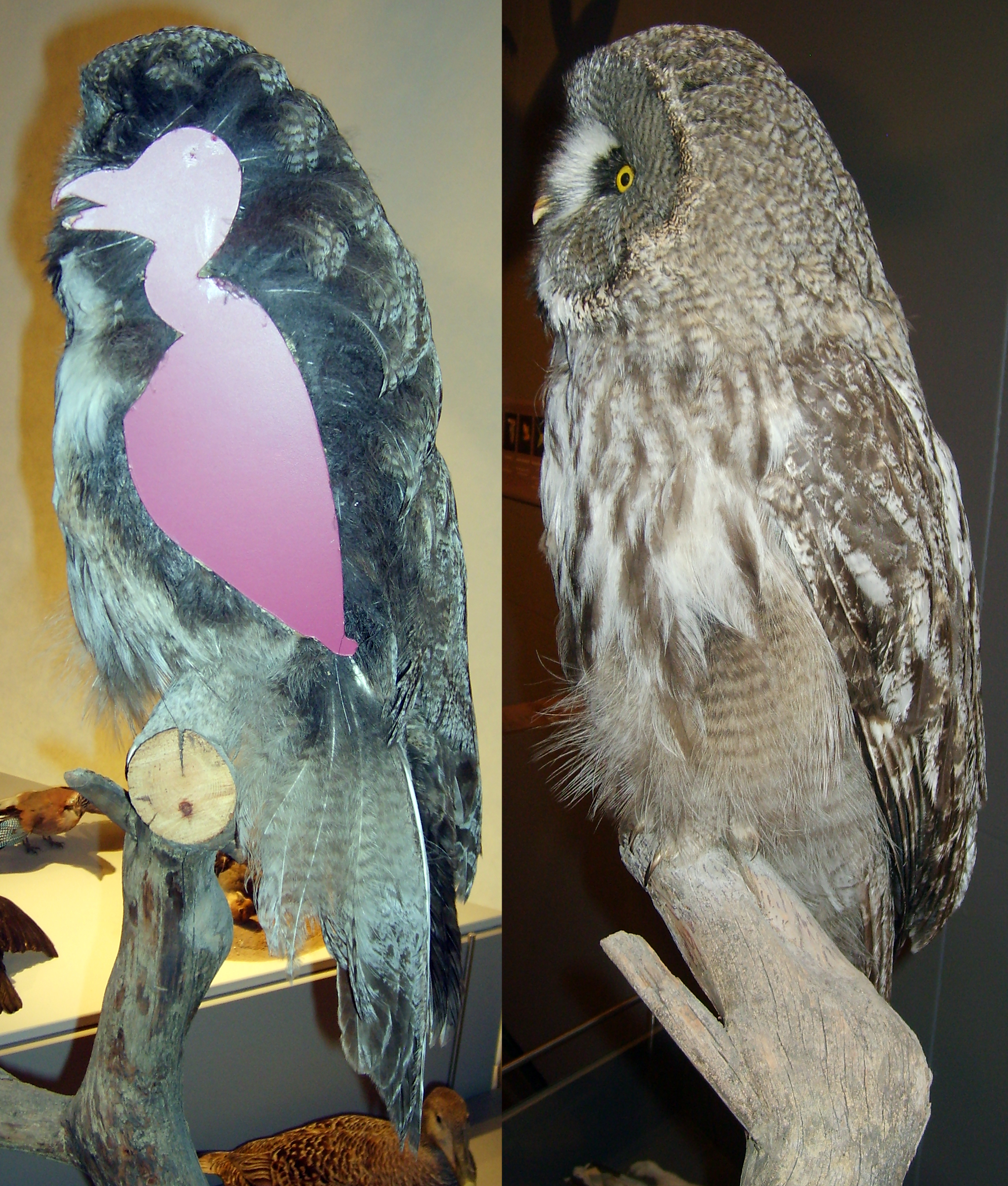|
Facial Disc
In ornithology, the facial disc is the concave collection of feathers on the face of some birds—most notably owls—surrounding the eyes. The concavity of the facial disc forms a circular paraboloid that collects sound waves and directs those waves towards the owl's ears. The feathers making up this disc can be adjusted by the bird to alter the focal length of this sound collector, enabling the bird to focus at different distances and allowing it to locate prey by sound alone under snow, grass, and plant cover. Other bird species, such as harriers, have less prominent facial discs. In harriers, the related term facial ruff refers to feathers around the neck that are raised in response to noise, essentially enlarging the facial disc and improving hearing. The barn owl has the most visually prominent facial disc, measuring about 110 mm (Simmons), while the great grey owl The great grey owl (''Strix nebulosa'') (also great gray owl in American English) is a very large owl, ... [...More Info...] [...Related Items...] OR: [Wikipedia] [Google] [Baidu] |
Tyto Alba Close Up
''Tyto'' is a genus of birds consisting of true barn owls, grass owls and masked owls that collectively make up all the species within the subfamily Tytoninae of the barn owl family, Tytonidae. Taxonomy The genus ''Tyto'' was introduced in 1828 by the Swedish naturalist Gustaf Johan Billberg with the western barn owl as the type species. The name is from the Ancient Greek ''tutō'' meaning "owl". The barn owl (''Tyto alba'') was formerly considered to have a global distribution with around 28 subspecies. In the list of birds maintained by Frank Gill, Pamela Rasmussen and David Donsker on behalf of the International Ornithological Committee (IOC) the barn owl is now split into four species: the western barn owl (''Tyto alba'') (10 subspecies), the American barn owl (''Tyto furcata'') (12 subspecies), the eastern barn owl (''Tyto javanica'') (7 subspecies) and the Andaman masked owl (''Tyto deroepstorffi''). This arrangement is followed here. Some support for this split was ... [...More Info...] [...Related Items...] OR: [Wikipedia] [Google] [Baidu] |
Ornithology
Ornithology is a branch of zoology that concerns the "methodological study and consequent knowledge of birds with all that relates to them." Several aspects of ornithology differ from related disciplines, due partly to the high visibility and the aesthetic appeal of birds. It has also been an area with a large contribution made by amateurs in terms of time, resources, and financial support. Studies on birds have helped develop key concepts in biology including evolution, behaviour and ecology such as the definition of species, the process of speciation, instinct, learning, ecological niches, guilds, island biogeography, phylogeography, and conservation. While early ornithology was principally concerned with descriptions and distributions of species, ornithologists today seek answers to very specific questions, often using birds as models to test hypotheses or predictions based on theories. Most modern biological theories apply across life forms, and the number of scientists ... [...More Info...] [...Related Items...] OR: [Wikipedia] [Google] [Baidu] |
Feather
Feathers are epidermal growths that form a distinctive outer covering, or plumage, on both avian (bird) and some non-avian dinosaurs and other archosaurs. They are the most complex integumentary structures found in vertebrates and a premier example of a complex evolutionary novelty. They are among the characteristics that distinguish the extant birds from other living groups. Although feathers cover most of the bird's body, they arise only from certain well-defined tracts on the skin. They aid in flight, thermal insulation, and waterproofing. In addition, coloration helps in communication and protection. Plumology (or plumage science) is the name for the science that is associated with the study of feathers. Feathers have a number of utilitarian, cultural, and religious uses. Feathers are both soft and excellent at trapping heat; thus, they are sometimes used in high-class bedding, especially pillows, blankets, and mattresses. They are also used as filling for winter ... [...More Info...] [...Related Items...] OR: [Wikipedia] [Google] [Baidu] |
Bird
Birds are a group of warm-blooded vertebrates constituting the class Aves (), characterised by feathers, toothless beaked jaws, the laying of hard-shelled eggs, a high metabolic rate, a four-chambered heart, and a strong yet lightweight skeleton. Birds live worldwide and range in size from the bee hummingbird to the ostrich. There are about ten thousand living species, more than half of which are passerine, or "perching" birds. Birds have whose development varies according to species; the only known groups without wings are the extinct moa and elephant birds. Wings, which are modified forelimbs, gave birds the ability to fly, although further evolution has led to the loss of flight in some birds, including ratites, penguins, and diverse endemic island species. The digestive and respiratory systems of birds are also uniquely adapted for flight. Some bird species of aquatic environments, particularly seabirds and some waterbirds, have further evolved for swimm ... [...More Info...] [...Related Items...] OR: [Wikipedia] [Google] [Baidu] |
Concave
Concave or concavity may refer to: Science and technology * Concave lens * Concave mirror Mathematics * Concave function, the negative of a convex function * Concave polygon, a polygon which is not convex * Concave set In geometry, a subset of a Euclidean space, or more generally an affine space over the reals, is convex if, given any two points in the subset, the subset contains the whole line segment that joins them. Equivalently, a convex set or a conve ... * The concavity of a function, determined by its second derivative See also * {{disambiguation, math ... [...More Info...] [...Related Items...] OR: [Wikipedia] [Google] [Baidu] |
Paraboloid
In geometry, a paraboloid is a quadric surface that has exactly one axis of symmetry and no center of symmetry. The term "paraboloid" is derived from parabola, which refers to a conic section that has a similar property of symmetry. Every plane section of a paraboloid by a plane parallel to the axis of symmetry is a parabola. The paraboloid is hyperbolic if every other plane section is either a hyperbola, or two crossing lines (in the case of a section by a tangent plane). The paraboloid is elliptic if every other nonempty plane section is either an ellipse, or a single point (in the case of a section by a tangent plane). A paraboloid is either elliptic or hyperbolic. Equivalently, a paraboloid may be defined as a quadric surface that is not a cylinder, and has an implicit equation whose part of degree two may be factored over the complex numbers into two different linear factors. The paraboloid is hyperbolic if the factors are real; elliptic if the factors are complex con ... [...More Info...] [...Related Items...] OR: [Wikipedia] [Google] [Baidu] |
Sound Wave
In physics, sound is a vibration that propagates as an acoustic wave, through a transmission medium such as a gas, liquid or solid. In human physiology and psychology, sound is the ''reception'' of such waves and their ''perception'' by the brain. Only acoustic waves that have frequencies lying between about 20 Hz and 20 kHz, the audio frequency range, elicit an auditory percept in humans. In air at atmospheric pressure, these represent sound waves with wavelengths of to . Sound waves above 20 kHz are known as ultrasound and are not audible to humans. Sound waves below 20 Hz are known as infrasound. Different animal species have varying hearing ranges. Acoustics Acoustics is the interdisciplinary science that deals with the study of mechanical waves in gasses, liquids, and solids including vibration, sound, ultrasound, and infrasound. A scientist who works in the field of acoustics is an ''acoustician'', while someone working in the field o ... [...More Info...] [...Related Items...] OR: [Wikipedia] [Google] [Baidu] |
Harrier (bird)
A harrier is any of the several species of diurnal hawks sometimes placed in the subfamily Circinae of the bird of prey family Accipitridae. Harriers characteristically hunt by flying low over open ground, feeding on small mammals, reptiles, or birds. The young of the species are sometimes referred to as ring-tail harriers. They are distinctive with long wings, a long narrow tail, the slow and low flight over grasslands and skull peculiarities. The harriers are thought to have diversified with the expansion of grasslands and the emergence of grasses about 6 to 8 million years ago during the Late Miocene and Pliocene. Taxonomy The genus ''Circus'' was introduced by the French naturalist Bernard Germain de Lacépède in 1799. The type species was subsequently designated as the western marsh harrier. Most harriers are placed in this genus. The word ''Circus'' is derived from the Ancient Greek ''kirkos'', referring to a bird of prey named for its circling flight (''kirkos'', ... [...More Info...] [...Related Items...] OR: [Wikipedia] [Google] [Baidu] |
Barn Owl
The barn owl (''Tyto alba'') is the most widely distributed species of owl in the world and one of the most widespread of all species of birds, being found almost everywhere except for the polar and desert regions, Asia north of the Himalayas, most of Indonesia, and some Pacific Islands. It is also known as the common barn owl, to distinguish it from the other species in its family, Tytonidae, which forms one of the two main lineages of living owls, the other being the typical owls (''Strigidae''). There are at least three major lineages of barn owl: the western barn owl of Europe, western Asia, and Africa; the eastern barn owl of southeastern Asia and Australasia; and the American barn owl of the Americas. Some taxonomic authorities classify barn owls differently, recognising up to five separate species; and further research needs to be done to resolve the disparate taxonomies. There is considerable variation of size and colour among the approximately 28 subspecies, b ... [...More Info...] [...Related Items...] OR: [Wikipedia] [Google] [Baidu] |
Great Grey Owl
The great grey owl (''Strix nebulosa'') (also great gray owl in American English) is a very large owl, documented as the world's largest species of owl by length. It is distributed across the Northern Hemisphere, and it is the only species in the genus '' Strix'' found in both Eastern and Western Hemispheres. In some areas it is also called Phantom of the North, cinereous owl, spectral owl, Lapland owl, spruce owl, bearded owl, and sooty owl. Description Adults have a large rounded head with a grey face and yellow eyes with darker circles around them. The underparts are light with dark streaks; the upper parts are grey with pale bars. This owl does not have ear tufts and has the largest facial disc of any raptor. There is a white collar or "bow tie" just below the beak. The long tail tapers to a rounded end. In terms of length, the great grey owl is believed to exceed the Eurasian eagle-owl and the Blakiston's fish owl as the world's largest owl. The great grey is outweighed ... [...More Info...] [...Related Items...] OR: [Wikipedia] [Google] [Baidu] |
Bird Anatomy
Bird anatomy, or the physiological structure of birds' bodies, shows many unique adaptations, mostly aiding flight. Birds have a light skeletal system and light but powerful musculature which, along with circulatory and respiratory systems capable of very high metabolic rates and oxygen supply, permit the bird to fly. The development of a beak has led to evolution of a specially adapted digestive system. Skeletal system Birds have many bones that are hollow ( pneumatized) with criss-crossing struts or trusses for structural strength. The number of hollow bones varies among species, though large gliding and soaring birds tend to have the most. Respiratory air sacs often form air pockets within the semi-hollow bones of the bird's skeleton. The bones of diving birds are often less hollow than those of non-diving species. Penguins, loons, and puffins are without pneumatized bones entirely. Flightless birds, such as ostriches and emus, have pneumatized femurs and, in the case of ... [...More Info...] [...Related Items...] OR: [Wikipedia] [Google] [Baidu] |


.jpg)

.jpg)




